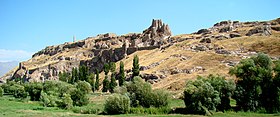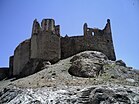Van (city)
| Van | |||||||
|---|---|---|---|---|---|---|---|
| Metropolitan municipality | |||||||
From top to bottom: Van Lake, Hoşap Castle, Akdamar Church, Van Lake, Akdamar Island, Tushba A mosque
|
|||||||
| Coordinates: 38°29′39″N 43°22′48″E / 38.49417°N 43.38000°ECoordinates: 38°29′39″N 43°22′48″E / 38.49417°N 43.38000°E | |||||||
| Government | |||||||
| • Mayor | Bekir Kaya (DBP) | ||||||
| Area | |||||||
| • District | 1,938.14 km2 (748.32 sq mi) | ||||||
| Elevation | 1,730 m (5,680 ft) | ||||||
| Population (2012) | |||||||
| • Urban | 370,190 | ||||||
| • District | 472,069 | ||||||
| • District density | 240/km2 (630/sq mi) | ||||||
Van (Armenian: Վան; Kurdish: Wan; Ottoman Turkish: فان) is a city in eastern Turkey's Van Province, located on the eastern shore of Lake Van. The city has a long history as a major urban area. It has been a large city since the first millennium BC, initially as the capital of Urartu in the 9th century BC and later as the center of the Armenian Kingdom of Vaspurakan. It remained an important center of Armenian culture until the Armenian Genocide of 1915. Today, Van has a Kurdish majority and a sizeable Turkish minority.
In 2010 the official population figure for Van was 367,419, but many estimates put it much higher with a 1996 estimate stating 500,000 and former Mayor Burhan Yengun is quoted as saying it may be as high as 600,000. The Van Central district stretches over 2,289 square kilometres (884 square miles). Van has another older name, which is Tushpa and was called so, when it was a capital of Urartan Armenian Kingdom.
Archaeological excavations and surveys carried out in Van province indicate that the history of human settlement in this region goes back at least as far as 5000 BC. The Tilkitepe Mound, which is on the shores of Lake Van and a few kilometres to the south of Van Castle, is the only source of information about the oldest culture of Van.
Under the ancient name of Tushpa, Van was the capital of the Urartian kingdom in the 9th century BC. The early settlement was centered on the steep-sided bluff now known as Van Castle (Van Kalesi), close to the edge of Lake Van and a few kilometers west of the modern city. Here have been found Urartian cuneiform inscriptions dating to the 8th and 7th centuries BC. In the trilingual Behistun inscription, carved in the order of Darius the Great of Persia, the country referred to as Urartu in Babylonian is called Armenia in Old Persian.
...
Wikipedia






